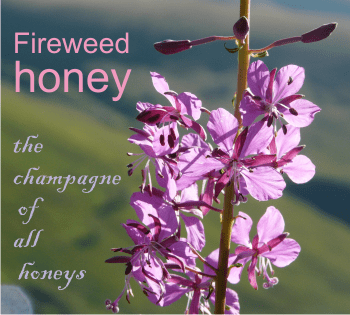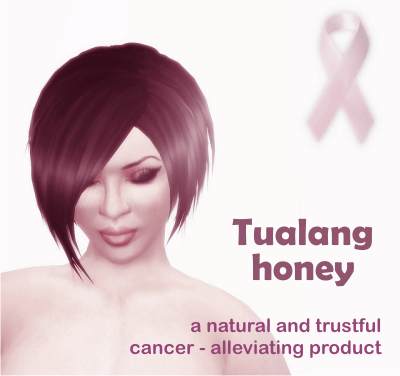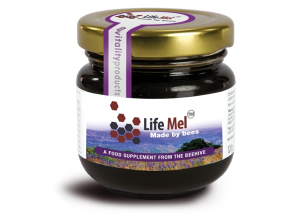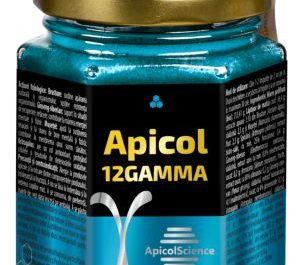Fireweed honey is a special kind of honey that pairs well with everything – always good to have at home. It doesn’t have exceptional health benefits though recent studies have shown that it has antimutagenic and antitumor properties.
Floral source: Fireweed
Scientific name: Chamaenerion angustifolium, aka Epilobium angustifolium
Other names: fireweed in North America, great willowherb in some parts of Canada, rosebay willowherb in Britain. It is considered that the name “fireweed” comes from the fact that this is often the first plant to grow back after a forest fire.
For example, one year after Mount St. Helens erupted in 1980 in Washington State, fireweed made 81% of the seedlings present. In Great Britain, this fireweed acquired the common name of bombweed during WWII, because of its ability to rapidly colonize bomb craters.
Characteristics: a perennial herbaceous plant in the willowherb family Onagraceae.
Native to: temperate Northern Hemisphere, including large parts of the boreal forests. It grows in all types of soil but if prefers dry, rocky, even depleted soil. In Alaska, fireweed is the most abundant and well-known wildflower.
Fireweeds provides an abundant food source for honeybees and hummingbirds and it also has several medicinal uses. The shoots are edible and the leaves can be eaten or used to make tea.
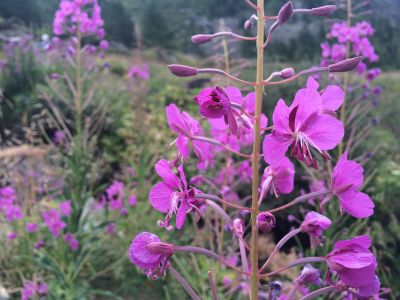
Flowers: The inflorescence blooms progressively from bottom to top, producing a gracefully tapered shape. In Alaska it reaches peak bloom by late July and early August, but in lower regions from June to September. The flowers are 2 to 3 cm in diameter, slightly asymmetrical, with 4 magenta to pink and purple petals and 4 narrower pink sepals behind. The protruding style has 4 stigmas.
Due to its beauty, fireweed is occasionally cultivated as an ornamental plant, though it can easily become an aggressive weed.
Pollination: The main pollinators of fireweed are honey bees, bumblebees and wasps with average mass exceeding 70 mg. (Dlusskiĭ GM et al., 2000)
Fireweed honey

Considered to be one of the finest honeys in the world, often referred to as the Champagne of all honeys, this type of honey pairs well with almost everything: on toast and bagels or used for grilling and with cheese.
It is harvested in northwestern United States, particularly in Alaska and also in northern European countries like Finland Sweden, Norway, Denmark and Britain.
Color: very light amber, even lighter after crystallization, with greenish tints in some regions.
Taste: delicate and very sweet with subtle tea-like notes, often with nice buttery finish
Flavor: light, fruity and smooth
Texture: fine, spreadable crystalline texture, probably the reason for which many beekeepers say it is like a champagne.
The following characteristics have been extracted from the study “Screening bioactivity and bioactive constituents of Nordic unifloral honeys” by Anneli Salonen et al. and published by Food Chemistry in 2017. The study analyzed 39 honey samples, fireweed included, from Finland, Sweden, Norway and Denmark. (For more details on fireweed honey and on all of the studied honeys, read the entire study.)
pH: 3.8 to 3.9
Water content: 16.4 ± 0.3 to 17.0 ± 0.2%
Electrical conductivity: low, 137 ± 0.3 to 161 ± 1.1
Fructose content: 42.3% to 45%
Glucose content: 30% to 32.7%
Sucrose content: 0.5 to 2.3
Other sugars: turanose (1.4), maltose (2.2), trehalose (0.8), isomaltose (0.9-2.4), erlose (0.6)
Flavonoid compounds: Kaempferol glycoside, Quercetin 3-O-rhamnoside, Kaempferol 3-O-rhamnoside, Rhamnetin de, Galangin der, Galangin der, Apigenin, Rhamnetin der, Methyl-naringenin, with a total of 10.22 ± 1.36 (high content)
Large quantities of kaempferol 3-O-rhamnoside (from the nectar of the flower) has been identified in fireweed honey from North Europe, but not in that from the North America (Gheldof, Wang, & Engeseth, 2002)
Phenolic compounds: Protocatechuic acid der, Vanillic acid, Benzoic acid, Tetragalloylglucose, a total of 2.64 ± 0.36 (low content). 62 ± 6 mg/kg
Cinnamic acids: Chlorogenic acid der, q-coumaric acid, Ferulic acid, Methyl-cinnamic acid der, Cinnamic acid der, Caffeic acid der, a total of 3.36 ± 0.70 (low content)
Antioxidant activity: very low, 3.09 ± 0.27 μmol TE/g measured by Oxygen Radical Absorbance Capacity (ORAC) for American fireweed honey (Gheldof N and Engeseth NJ., 2002)
Antibacterial activity: high inhibition of 30% honey dilutions against P. aeruginosa and S. aureus. Also high inhibition against the growth of Streptococcus pneumoniae and S. pyogenes for 20% fireweed honey dilutions, as shown by Huttunen et al. (2012).
Not real fireweed honey
Because of the scarcity and high price of true fireweed honey, in Alaska there is a habit of making an infused fireweed honey, by boiling the blossoms in a mixture of sugar and water.
Health benefits of fireweed honey
It’s honey, so it has the regular raw honey’s health benefits, that we know too well. In addition, every type of honey has some particularities according to its floral source. As a rule honey takes over the medicinal properties of the flower it’s made of. Fireweed honey has the following particularities:
Antimutagenic and antitumor effects
The food we eat today is not very healthy, we all know this. In these times all we care is the taste and how well it sells.
During the process of frying and roasting, some substances are built (called heterocyclic amines, like Trp-p-
1), which are mutagenic substances that act directly or indirectly by promoting mutations of genetic structure.
Trp-p-1 (3-Amino-1,4-dimethyl-5H-pyridol [4,3-b] indole) is a commonly encountered food mutagen that has been demonstrated to be mutagenic in bacteria and carcinogenic in animals (humans included).
Honey is a natural product that fights against these mutagens, due to its complex composition of sugars and biologically active components we call antioxidants. Sugars have been reported to display both mutagenic and antimutagenic effects in different systems; antioxidants often display antimutagenic activity.
• The study Antimutagenic effect of various honeys and sugars against Trp-p-1., by Wang XH et al. from University of Illinois, Urbana, USA, published in 2002 the antimutagenic activity of honeys from 7 different floral sources (acacia, buckwheat, fireweed, soybean, tupelo and Christmas berry) against Trp-p-1. The scientists tested them via the Ames assay and compared them to that of a sugar analogue and to individually tested simple sugars.
The results showed that all honeys exhibited significant inhibition of Trp-p-1 mutagenicity. Each displayed significant degrees of inhibition of mutagenicity above concentrations of 1 mg/mL, with individual variations in degree of effectiveness. Buckwheat honey displayed the greatest inhibition at 1 mg/mL, with slightly less effectiveness at higher concentrations.
A sugar analogue demonstrated a pattern of inhibition similar to that of the honeys, with enhanced antimutagenicity at concentrations greater than 1 mg/mL. Glucose and fructose were also similar to honeys and were more antimutagenic than maltose and sucrose.
Moisturizing effect
Fireweed honey is largely used in cosmetics, in scrubs and creams to make the skin soft and silky. It is known to have a powerful natural moisturizer effect.
Where can we find fireweed honey?
• On Amazon.com, produced by Winter Park Honey or by Healthy Option USA.
• Annas Honey sells a 18 oz jar;
• Dejon Delights sells firewwed honey made in southest Alask.
• Alaska Wild Teas sells a 8 oz jar.
=============
=============
References:
Picture credits: pixabay.com under CC
https://en.wikipedia.org/wiki/Chamaenerion_angustifolium
http://www.missouribotanicalgarden.org/PlantFinder/PlantFinderDetails.aspx?taxonid=297622&isprofile=0&
WANG, X H; ANDRAE, L; ENGESETH, N J (2002) Antimutagenic effect of various honeys and sugars
against Trp-p-1. Journal of agricultural and food chemistry 50 (23): 6923-6928.

